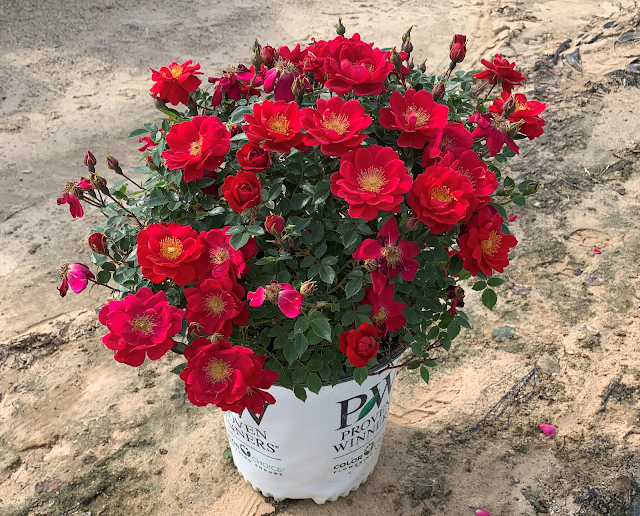It’s a shame that Honeysuckle vine has gotten a bad rap.
Lonicera japonica, the Japanese Honeysuckle vine is to blame of course. It has proven to highly invasive, particularly in the South East. Birds love the fleshy fruit and deposit the seeds along fence rows and thus miles of fence lines in the East have been engulfed by this aggressive vine. As with most invasive plants, it is a regional issue. The USDA plant database shows it as being escaped in Michigan, however, I’ve never seen it to be a problem. The point is that there are many excellent vines in this genera that are well behaved and garden worthy depending upon where you live. In addition there are also native species that get neglected simply because of this guilt by association.
On my trip to England, I was fortunate enough to catch some of the early flowering varieties of
Lonicera in bloom at the RHS trials in Wisley Gardens. The bright orange, red and yellow flowers drew me in and the thick, sweet fragrance lured me even closer and I ran from plant to plant clicking photos and sticking my nose into each bloom inhaling the rich aroma. These are twining vines and they need support to climb. They will not adhere to brick or bark as would ivy or climbing Hydrangea. And as a twining vines go these plants require more structural support than Wisteria or Clematis. At Wisley they loosely wrapped a tube of chicken wire around wooden poles with the vines planted in between the two. This worked brilliantly, as the British say.
It was a tad early to see the majority of these vines in flower, so what follows is a snapshot of some of the early flowering varieties.

The showiest plant in bloom was
Lonicera x
heckrotti (Goldflame Honeysuckle) which to the best of my knowledge is a hybrid that contains the genes of three species; our native
Lonicera sempervirens,
Lonicera etrusca a Meterianian species and
L. implexa a species native to Africa. It is an everblooming vine with rose-pink tubular flowers adorned with an orange-yellow interior. The plants I sniffed were wonderfully sweet and intoxicating.
Lonicera x italica is another early bloomer. It too was fragrant but the blooms were not as showy as Goldflame.

Our native species
Lonicera sempervirens was in flower. While it does not have the fragrance, I love the contrast between the intense orange-red flowers its attractive blue-green foliage. The flowers are more pendulous, more tubular than other and so you only get a slight glimpse of the yellow hues hidden within the tube.

Two
Lonicera periclymenum (Woodbine Honeysuckle) cultivars were in flower. The cultivar ‘Munster’ sported yellow flowers with a hint of pink in the buds, while ‘La Gaserie’ was a lighter cream-yellow and pink in bud. Both plants had good fragrance. The cultivars ‘Belgica Select’ and ‘Graham Thomas’ were showing buds but were not in flower. The popular cultivar ‘Serotina’ was even further behind.
Lonicera x tellmanniana, Lonicera henryi, Lonicara x brownii and their cultivars were not yet in flower.
If you are interested in learning more about these interesting vines I would suggest you visit
http://www.clematis.com.pl/wms/2494791.html. It is the website of ornamental vine expert and Clematis breeder Szczepan Marczyński.

I’ve visited Szczepan in Poland a few years ago and fortunately for me the
Lonicera vines were in full bloom. Oh how I love fragrant plants.






















 I’ve visited Szczepan in Poland a few years ago and fortunately for me the Lonicera vines were in full bloom. Oh how I love fragrant plants.
I’ve visited Szczepan in Poland a few years ago and fortunately for me the Lonicera vines were in full bloom. Oh how I love fragrant plants.
